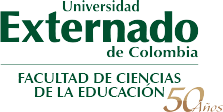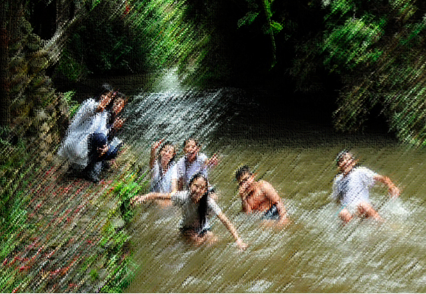21 de febrero de 2019
Rural Context: A Source to Contextualize Tasks for Oral Communication Micro-skills
María Isabel Munévar Jerez M.A.
Rural EFL teachers have a foremost commitment in making students aware of learning a language in a meaningful and contextualized way. Daily rural activities and experiences became the main source of students’ oral communication both in the English classroom and the countryside. This article describes the pedagogical experience of developing six contextualized worksheets centered on rural tasks aimed at enhancing two oral communication micro-skills in seventh graders, in a public rural school in Tabio, Cundinamarca.
The proposed worksheets included topics related to meaningful tasks founded on the rural context. Among these tasks, I considered what people can do in the river, the way people take care of animals, the fruits and vegetables they grow, the occupations of the family members and their physical descriptions, and activities that the academic and administrative staff do. Since contextualization responds to the particular needs of the learners in specific contexts (Graves, 1996; Núñez & Téllez, 2008, 2009, 2015; Núñez, et al. 2013), these contextualized materials fostered students’ communication regarding likes, feelings and thoughts to show experiences and situations within the rural environment.
A key aspect of this pedagogical experience was the idea of inviting students to be the main characters of the worksheets. They appeared in real pictures that illustrated the task to be developed by themselves in each one of the contextualized tasks proposed in the worksheets. To do so, students and the teacher chose two scenarios, the school and countryside to take the pictures illustrating people’s usual activities in the rural context. Then, when the worksheets were printed, the students worked on those tasks to accomplish the communicative function of the language (Brown, 2001), supported by body language (verbal and non-verbal language).
One significant aspect of developing the contextualized worksheets was students’ eagerness to see themselves in the real and full color pictures that portrayed their rural daily-life. This attracted their attention and raised their interest in the tasks completion while developing the abovementioned oral communication micro-skills. The connection with the layout and tasks strengthened the students’ empathy towards the materials.
In that way, students enjoyed practicing English and learnt the language within the rural setting that offers attractive visual locations where the daily activities occur. According to Lamb (2011), “Visual appeal is key not only in its ability to grab the interest of your reader but also to help the readers remember the details of your message” (p.14). In this regard, students evinced both emotion and willingness when they interacted while working on the tasks, as a result of their attractive visual layout.
This fact evinced the effectiveness of the rural context daily life as the source for the development of learning activities to foster students’ oral interactions when describing activities that were close to their everyday real-life. On this matter, Tomlinson (1998) stated that suitable and effective materials inspire cognitive and emotional connections, which allowed students to raise their awareness to express themselves in the target language within a contextualized scenario.
For instance, by including real life situations along worksheet 1, when the students went to the river and enjoyed swimming and splashing the water, expressing abilities and inabilities of farm and domestic animals, or describing vegetables and fruits that people grow in Río Frio –Tabio were significant activities for students. The tasks emphasized on what they currently did in their rural context. In addition, students could practice expressions to describe what they were doing, to refer to abilities and inabilities of farm animals and to communicate how people grow fruits and vegetables on a farm they visited due to the fact of being out of the classroom, and experienced what the tasks were suggesting in the contextualized worksheets.
This situation set a link between students and the use of English. Therefore, they could feel comfortable when communicating orally. Núñez and Téllez (2009) affirmed that “effective materials make learners feel comfortable and confident because both the content and type of activities are perceived by them as significant and practical to their lives” (p. 184). Thus, rural context tasks engaged and motivated students to practice in a meaningful and enjoyable way fostering activities they do or know, as evinced in Worksheet 2.
Similarly, worksheets 4 and 5 highlighted tasks they developed in the school, contrasting them with the ones developed out of the classroom such as: describing their family occupations or jobs, showing and labelling school parts and describing themselves. Regarding worksheet 6, students were exposed to learn English in an easy and amusing way although they struggled using it. On this matter, Willis (1996) stated that “the tasks should expose learners to spontaneous language in appropriate circumstances, and allow them to use it, since most will need to cope with it in real life” (p. 33). Giving students the opportunity to perform usual rural tasks while learning the foreign language allowed them to recognize their abilities to speak in English when using the communicative functions of language, supported by the use of body gestures.
When communicating, both verbal and non-verbal language are integrated. In this regard, Brown (2001) asserted that “accomplish appropriately communicative functions according to situations, participants, and goals; and use facial features, kinesics, body language, and other nonverbal cues along with verbal language to convey meanings” (p. 272) helped students to interact. Similarly, students could communicate what they wanted to mean by using their body gestures when necessary. For instance, students could mimic actions in the river, animals’ abilities, their family jobs, and physical appearance, among others. Savu (2015) affirmed that 93% of communication is conveyed by gesture, and 7% is expressed verbally. Thus, the tasks proposed in the worksheets included activities aimed at enhancing the use of language to accomplish its communicative purpose supported by body language. As a result, students could express feelings, thoughts and ideas, and it is worth mentioning that the methodology adopted within the materials fostered students’ communicative competence.
Summing up, contextualized materials responded to the particular needs of the students living and studying in a specific rural context. In the same way, authentic tasks allowed learners to use the language as they use it in the ‘real world’ (Tomlinson, 2011) which in this case took place out of the classroom. Thence, teachers in rural settings must take into account that cultural backgrounds are part of students’ learning process, and it directly contributes to students’ oral communication, as they could express what they wanted by resorting to both verbal language (communicative functions) and non-verbal language (body movements and gestures). Teachers who implement this type of material can realize that vocabulary and tasks linked to the rural context are resources to improve speaking skills. Likewise, when teachers develop contextualized materials, the outcomes favor the students’ learning environment and motivation towards English as a Foreign Language communication.
________________________
References
Bonilla, S., & Cruz, F. (2003). Critical socio-cultural elements of the intercultural endeavour of English teaching in Colombian rural areas. PROFILE Issues in Teachers’ Professional Development, 16 (2), 117-133. doi:10.15446/ profile.v16n2.40423
Brown, H. (2001). Teaching by principles: an interactive approach to language pedagogy. New York, NY: Addison Wesley Longman, Inc.
Graves, K. (1996). Teachers as course developers. Cambridge, UK: Cambridge University Press.
Lamb, S. E. (2011). How to write it: A complete guide to everything you’ll ever write. New York, NY: Ten Speed Press.
Ministerio de Educación Nacional [MEN]. (2016). Pedagogical principles and guidelines: Suggested English curriculum. Retrieved March 8, 2017 from http://aprende.colombiaaprende.edu.co/sites/default/files/naspublic/Anexo 15 Pedagogical Principles and Guidelines.pdf
Nuñez, A., & Téllez, M. (2009). ELT materials: The key to fostering effective teaching and learning settings. PROFILE Issues in Teachers’ Professional Development, 11(2), 171-186. Retrieved April 22, 2017 from https://revistas.unal.edu.co/index.php/profile/article/view/11449
Núñez, A., Téllez, M. F., & Castellanos, J. (2013). Proposal for the research line materials development and didactics. Bogotá, Colombia: Universidad Externado de Colombia.
Nuñez, A., & Téllez, M. F. (2015). Reflections on teachers’ personal and professional growth through a materials development seminar. HOW, 22(2), 54-74.
Savu, E. (2015). What to teach learners to make them speak like pros-tips on successful oral presentations. In I. Boldea (Coordinator) Discourse as a form of multiculturalism in literature and communication. Tîrgu Mureș: Archipelag XXI Press Retrieved June 2, 2016 from http://www.upm.ro/ldmd/LDMD-03/Lds/Lds%2003%2015.pdf
Tomlinson, B. (1998). Materials development in language teaching. Cambridge, UK: Cambridge University Press.
Tomlinson, B. (2011). Materials development in language teaching. Cambridge, UK: Cambridge University Press.
Willis, J. (1996). A framework for task-based learning. Essex, UK: Longman.


